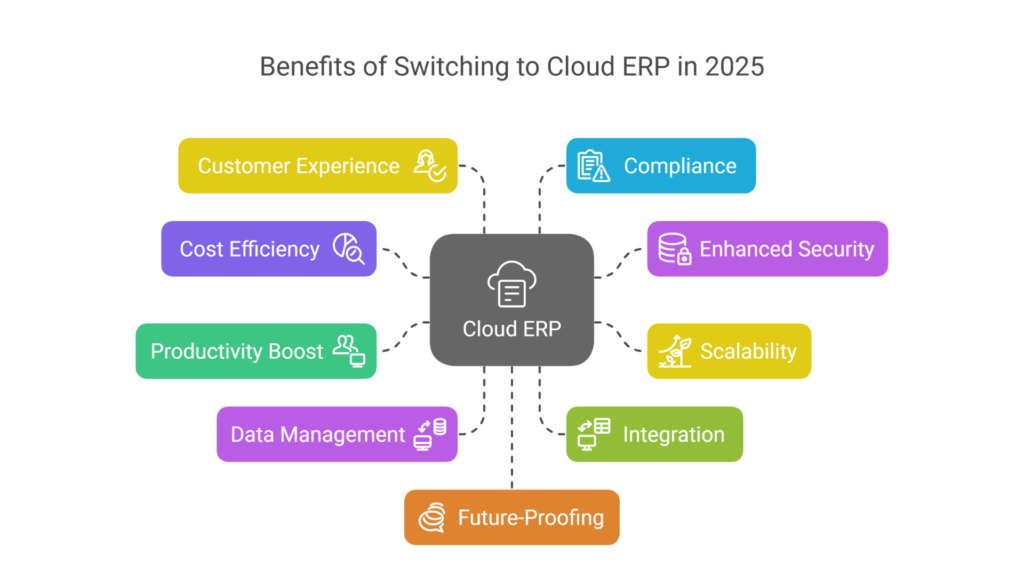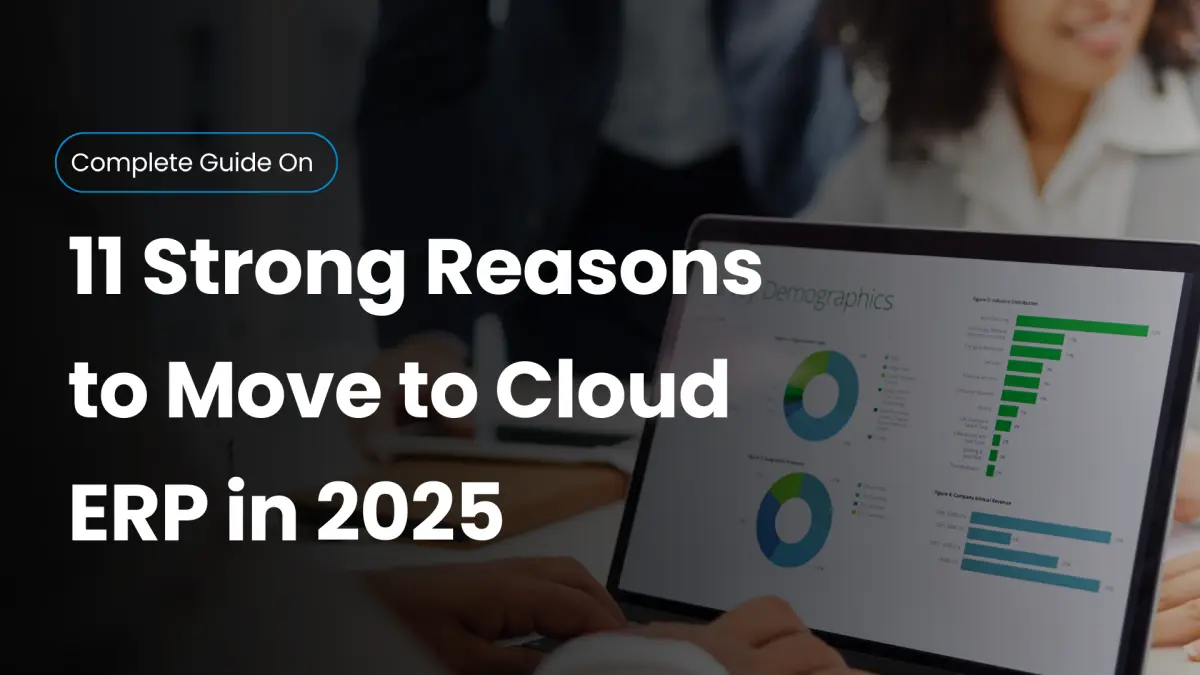In 2025, more businesses are turning to cloud-based systems, and Cloud ERP adoption trends are leading the way. This article covers 11 strong reasons why moving to Cloud ERP is a smart move for companies of all sizes. From greater flexibility and stronger security to real-time insights, you’ll see why more organizations are making the switch.
Keep reading to find out how Cloud ERP can simplify operations, lower costs, and help your business stay ahead in today’s fast-changing digital world.
Table of Contents
- Cloud ERP Adoption Trends for 2025
- 11 Strong Reasons to Switch to Cloud ERP in 2025
- 1. Lower Initial Costs and Flexible Pricing
- 2. Better Security and Data Protection
- 3. Greater Flexibility and Growth Potential
- 4. Quick Setup and Immediate Benefits
- 5. Increased Productivity and Collaboration
- 6. Automatic Software Updates and Maintenance
- 7. Centralized and Real-Time Data Management
- 8. Better Integration with Other Business Systems
- 9. Improved Customer Experience
- 10. Easier Compliance and Risk Management
- 11. Future-Proof Your Business with Cloud ERP
- Cloud ERP vs. On-Premise ERP: A Side-by-Side Comparison
- How to Successfully Migrate to Cloud ERP
- Overcoming Common Challenges When Moving to Cloud ERP
- Real-World Examples of Cloud ERP Success:
- Conclusion: Why 2025 is the Year to Make the Shift to Cloud ERP
Cloud ERP Adoption Trends for 2025
Cloud ERP is gaining major momentum in 2025, as companies across every industry realize its powerful benefits. Businesses are choosing cloud solutions for their flexibility, stronger security, and ability to make faster decisions.
Here are some key trends:
- Market Growth: The global Cloud ERP market is expected to grow by around 10% each year.
- AI & Automation: New technologies are making ERP systems smarter, improving efficiency and forecasting.
- Remote Work: Cloud ERP supports easy teamwork from anywhere, making it ideal for remote and hybrid workplaces.
As the need for speed and flexibility grows, Cloud ERP is becoming the clear choice for future-focused businesses.
11 Strong Reasons to Switch to Cloud ERP in 2025

1. Lower Initial Costs and Flexible Pricing
Cloud ERP uses a subscription model, which helps businesses avoid large upfront costs for hardware and servers. Instead of a hefty capital investment, businesses pay a monthly fee based on usage:
- Subscription vs. Capital Investment: No huge one-time payments for equipment.
- Reduced IT Costs: Cloud providers take care of maintenance and updates, lowering IT expenses.
2. Better Security and Data Protection
With Cloud ERP, businesses benefit from top-tier security to protect sensitive information. Your data is safe with continuous monitoring and advanced protection systems.
- Continuous Threat Monitoring: Identifies risks and protects your business from potential cyberattacks.
- Regulatory Compliance: Cloud ERP ensures your business stays in line with laws like GDPR and HIPAA.
3. Greater Flexibility and Growth Potential
As your business grows, Cloud ERP grows with you. Easily add users, locations, or features to meet your changing needs.
- Simple Scalability: Expand as your business increases in size, without extra complexity.
- Adapt to Market Changes: Easily adjust to new demands or business shifts, keeping your operations smooth.
4. Quick Setup and Immediate Benefits
Cloud ERP doesn’t require long installation times. Start using it right away and access your data from anywhere
- No Complicated Installations: Set up is fast and straightforward.
- Instant Access: Begin using the system immediately and see benefits from day one.
5. Increased Productivity and Collaboration
Cloud ERP enhances collaboration and boosts productivity, especially in today’s remote-first world. With features designed for mobile and remote access, your teams can work from anywhere, anytime.
- Remote Access & Mobile-Friendly: Stay connected to your data on the go, ensuring that work doesn’t stop when you’re away from the office.
- Real-Time Data Sharing: Share important information instantly across teams, streamlining communication and decision-making.
6. Automatic Software Updates and Maintenance
With Cloud ERP, your system is always up-to-date—no need for manual updates or disruptions to your business.
- No Disruption: Get the latest features and improvements automatically without interrupting your operations.
- No IT Overhead: Your cloud provider handles all updates and maintenance, freeing up your internal team from tech management.
7. Centralized and Real-Time Data Management
Cloud ERP offers a single source of truth for all your business data, making it easier to manage and analyze.
- Unified Data: All information—finance, sales, inventory—lives in one place, ensuring consistency across departments.
- Up-to-Date Decision-Making: Make decisions based on the latest, real-time data, improving your responsiveness and agility.
8. Better Integration with Other Business Systems
Cloud ERP easily integrates with your existing tools, such as CRM, HRM, and financial systems.
- Seamless Integration: Connect your Cloud ERP with other business systems effortlessly, ensuring a smooth flow of data across departments.
- Automated Data Flow: Reduce manual data entry and eliminate errors by automating information transfer between systems.
9. Improved Customer Experience
Cloud ERP helps businesses gain valuable insights into customer behavior, allowing for more tailored interactions and quicker responses.
- Better Insights: Track customer preferences, purchasing patterns, and behavior to improve service delivery.
- Faster Response Times: Speed up support and order fulfillment with real-time access to data, resulting in a smoother customer experience.
- Personalized Services: Offer customized solutions based on customer insights, boosting satisfaction and loyalty.
10. Easier Compliance and Risk Management
Compliance with regulations is simplified with Cloud ERP’s built-in features, helping businesses stay on top of industry standards.
- Regulatory Compliance: Cloud ERP systems come with built-in tools to ensure compliance with GDPR, HIPAA, and other regulations.
- Minimized Risk: Advanced data security features protect against breaches, reducing the risk of legal and financial repercussions.
11. Future-Proof Your Business with Cloud ERP
Cloud ERP isn’t just about managing operations today—it’s about positioning your business for the future.
- Supports Innovation: With the latest technology integrated, Cloud ERP helps businesses stay innovative and competitive.
- Stay Ahead of Trends: Adapt quickly to industry changes and evolving customer demands, ensuring you’re always a step ahead.
Cloud ERP vs. On-Premise ERP: A Side-by-Side Comparison
When choosing between Cloud ERP and on-premise ERP, businesses need to weigh key differences in cost, speed, and maintenance.
Cost Comparison
- Cloud ERP: Operates on a subscription model with predictable monthly or annual fees—no large upfront investment needed.
- On-Premise ERP: Requires significant capital to purchase hardware, licenses, and cover ongoing maintenance costs.
Speed of Deployment
- Cloud ERP: Quick to deploy, often going live within weeks. Businesses can start benefiting from new efficiencies almost immediately.
- On-Premise ERP: Longer setup time with hardware installation, software configuration, and staff training, delaying ROI.
Maintenance
- Cloud ERP: Automatic updates ensure businesses always have the latest features without disrupting operations.
- On-Premise ERP: IT teams must manually manage updates, patches, and security fixes—costing time and increasing the risk of downtime.
Choosing Cloud ERP gives businesses a faster, more flexible, and cost-effective way to stay agile and future-ready.
How to Successfully Migrate to Cloud ERP
Switching to Cloud ERP can be a huge win for any business, but it needs a clear, well-planned approach. Here’s a simple guide to getting it right:
Step 1: Understand Your Needs and Pick the Best Solution
First, review your current processes, challenges, and future goals. Then, select a Cloud ERP that fits your industry, business size, and growth plans.
Step 2: Create a Migration Plan
Build a step-by-step plan covering timelines, how data will be moved, how the new system will connect with your old tools, and what backup plans are in place if any issues come up.
Step 3: Train Your Team and Launch
Make sure your employees are ready for the change. Offer practical training so they feel confident using the system. Consider a phased launch to fix small problems early and make the transition smoother.
Step 4: Keep Improving After Go-Live
Once the system is live, monitor how it’s performing. Gather feedback, tweak workflows, and look for ways to keep getting better. A strong Cloud ERP will grow and improve along with your business.
By following these steps, companies can shift to Cloud ERP smoothly and start seeing the benefits faster.
Overcoming Common Challenges When Moving to Cloud ERP
Migrating to a Cloud ERP system can be a game-changer, but a few common challenges of ERP Implementation may pop up. Here’s how businesses can tackle them:
 Multiracial business people using virtual reality goggles work inside metaverse cyberspace – VR lifestyle technology concept – Focus on senior man face
Multiracial business people using virtual reality goggles work inside metaverse cyberspace – VR lifestyle technology concept – Focus on senior man face
Handling Employee Pushback:
New systems can feel intimidating. Clear communication, early involvement, and strong training programs can ease employee concerns and help them embrace the change.
Managing Data Migration and Integration:
Shifting data can be complicated. Careful planning, cleaning up old data, and getting help from experienced partners can ensure the transition is accurate and stress-free.
Keeping Data Secure:
Security must be a top priority. Choosing a trusted Cloud ERP vendor with strong encryption, global compliance certifications (like GDPR or HIPAA), and a solid security record will keep sensitive data safe during the move.
Facing these challenges the right way sets businesses up to unlock the full power of Cloud ERP without major disruptions.
Real-World Examples of Cloud ERP Success:
Cloud ERP is transforming industries by boosting efficiency, cutting costs, and improving customer experiences.
Manufacturing:
A leading manufacturer adopted Cloud ERP to streamline production and inventory management. The result? Faster workflows, lower operational costs, and better supply chain visibility.
Retail:
A major retailer integrated Cloud ERP to enhance inventory control and personalize customer service. With real-time data, they reduced stockouts and offered seamless shopping experiences across all channels.
Healthcare:
A growing healthcare industry provider turned to Cloud ERP to unify operations and meet strict compliance standards. The system helped automate patient data management, improve scheduling, and maintain HIPAA compliance effortlessly.
Across industries, Cloud ERP delivers measurable results, helping businesses stay agile, competitive, and ready for future growth.
Conclusion: Why 2025 is the Year to Make the Shift to Cloud ERP
Cloud ERP brings real advantages that businesses can no longer afford to ignore. Lower upfront costs, better security, faster setup, and smarter data management are just a few reasons why more companies are making the move.
In 2025, businesses that switch to Cloud ERP will be more flexible, more efficient, and better prepared to handle change. Now is the perfect time to invest in technology that helps teams work smarter, serve customers better, and grow without limits.
Choose Infintrix Technologies for a seamless migration to Cloud ERP. Let us help transform your business—contact us today!


